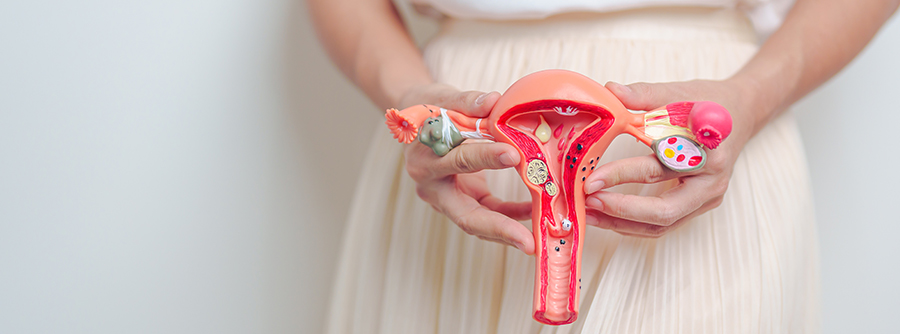Over the last few years, you're bound to have heard a lot about this condition known as endometriosis. So what is it really? We'll try to answer all your questions on the subject.
What is endometriosis?
It's a disease that has long been ignored and misunderstood, but the number of cases has been increasing in recent years, probably because we are now able to diagnose it!
Endometriosis affects one in ten menstruating women. It is the uncontrolled implantation of endometrial tissue (tissue of the uterine lining) outside the uterine cavity.
The cells naturally responsible for lining the uterine mucosa to accommodate the future embryo develop to a greater or lesser extent in other organs, such as the ovaries, peritoneum, liver and sometimes even the lungs, and bleed in turn at the time of menstruation under the effect of hormones. This bleeding causes a great deal of pain, and results in the local production of scar tissue (fibrosis), leading to adhesions that restrict bodily movements and can obstruct certain ducts, such as the fallopian tubes.
This has the effect of significantly reducing fertility, as the oocyte is stopped or slowed down in its journey and never reaches the uterine cavity.
Most people suffering from endometriosis also have irritable bowel syndrome, with problems with regular bowel movements, bloating, etc.
The pathophysiology of endometriosis has not been established and involves a number of hypotheses, in particular the theory of regurgitation known as the "implantation theory". During menstruation, under the effect of uterine contractions, part of the blood is regurgitated in the fallopian tubes to arrive in the abdomino-pelvic cavity. This blood contains endometrial cells, fragments of uterine mucosa, which, instead of being destroyed by the immune system, implant themselves and then, under the effect of subsequent hormonal stimulation, proliferate in neighbouring organs (peritoneum, ovary, fallopian tube, intestine, bladder, ureter, diaphragm, etc.). This theory would explain the majority of cases of endometriosis.
Endometriosis, a complex disease
It has even been said that there is not one but "many" endometrioses, because this disease does not develop in the same way from one person to another... There are no certainties about endometriosis, except that it takes different forms in different places and in different proportions from one person to another.
There are 3 forms of endometriosis.
- superficial (or peritoneal) endometriosis, which refers to the presence of ectopic endometrial implants located on the surface of the peritoneum,
- Ovarian endometriosis: ovarian endometriosis is a cyst of the ovary characterised by its chocolate-coloured liquid content,
- deep pelvic (or subperitoneal) endometriosis corresponds to lesions which infiltrate more than 5 mm below the surface of the peritoneum. Deep endometriosis typically affects the uterosacral ligaments (50% of cases), the posterior vaginal cul-de-sac (15%), the intestine (20-25%), mainly represented by the anterior surface of the rectum and the recto-sigmoid junction, the bladder (10%), the ureters (3%) and beyond the pelvic cavity, the sigmoid, the right colon, the appendix and the terminal ileum are the most frequent locations. There are also extra-pelvic forms of endometriosis (diaphragmatic, thoracic in particular).
In 1/3 of cases, endometriosis does not develop, or even regresses spontaneously or with treatment (medical or surgical), particularly for superficial forms. However, we also know that some cases of endometriosis develop into severe forms that are complex to treat. That's why it's important to diagnose them as early as possible!
There is no relationship between the intensity of pain and the type of endometriosis. For example, superficial endometriosis can be very painful due to the presence of numerous nerves in the pelvic cavity.
Endometriosis is a benign disease in the medical sense of the term, i.e. it is not life-threatening, but it can be extremely painful. Some forms can disable the daily lives of sufferers and constitute an invisible handicap.
Little-known origins
In 1890, the German pathologist F. Von Recklinghausen proposed a theory based on the proliferation of residual embryonic cells from the genital tract of the embryo at a stage that was still sexually undifferentiated. These cells would develop under the influence of certain stimuli and induce endometriosis. Endometriosis lesions have been found on foetuses.
Another theory is that of "distant migration" via lymphatic and vascular vessels.
Certain lesions could be the result of a transformation of normal cells into cells typical of endometriosis (metaplasia theory).
As mentioned above, the most commonly accepted hypothesis is the so-called "menstrual reflux theory" or "implantation theory" described by the American gynaecologist John A. Sampson in 1927. But menstrual reflux exists in almost all women, and only 10% develop endometriosis. This could be due to a "fault" in the immune system of some women, which may not be playing its role in eliminating these cells at the end of the cycle. Research on this subject is ongoing.
Pregnancy that cures endometriosis.... a popular misconception!
In fact, it seems more realistic to consider that pregnancy does not "cure" endometriosis, but significantly improves it or prevents a worsening of the situation by offering a period of remission. It is not uncommon for symptoms to return after childbirth.
Let's encourage early diagnosis!
Most people with severe endometriosis complain of having suffered violent gynaecological pain since puberty. But because it is socially accepted that it is "normal" for women to suffer during their periods, or because the menstrual pain of teenage girls is more or less taken into account, possible endometriosis is rarely mentioned.
However, 1 in 2 teenage girls complaining of violent gynaecological pain, with or without digestive or urinary problems, or presenting continuous pain outside their periods, were diagnosed during a laparoscopy.
Today, endometriosis is diagnosed, often by chance, with an average delay of seven years, during which time the disease has had time to cause significant damage to various organs.
What can be done to relieve the pain?
Whatever the severity of the endometriosis, it is advisable to eat a balanced diet that limits the oxidative stress that causes inflammation. To achieve this, favour a diet with a low glycaemic index.
Phytotherapy treatments such as gemmotherapy (bud macerate) can help regulate hormonal cycles.
Osteopathy and acupuncture help to balance the hormonal cycle and maintain good organic mobility.
Magnetic therapy can also help regulate cycles and reduce overall inflammation.

